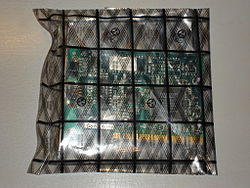


A Faraday cage or Faraday shield is an enclosure used to block some electromagnetic fields. A Faraday shield may be formed by a continuous covering of conductive material, or in the case of a Faraday cage, by a mesh of such materials. Faraday cages are named after scientist Michael Faraday, who first constructed one in 1836. [1]
Contents
Faraday cages work because an external electrical field will cause the electric charges within the cage's conducting material to be distributed in a way that cancels out the field's effect inside the cage. This phenomenon can be used to protect sensitive electronic equipment (for example RF receivers) from external radio frequency interference (RFI) often during testing or alignment of the device. Faraday cages are also used to protect people and equipment against electric currents such as lightning strikes and electrostatic discharges, because the cage conducts electrical current around the outside of the enclosed space and none passes through the interior.
Faraday cages cannot block stable or slowly varying magnetic fields, such as the Earth's magnetic field (a compass will still work inside one). To a large degree, however, they shield the interior from external electromagnetic radiation if the conductor is thick enough and any holes are significantly smaller than the wavelength of the radiation. For example, certain computer forensic test procedures of electronic systems that require an environment free of electromagnetic interference can be carried out within a screened room. These rooms are spaces that are completely enclosed by one or more layers of a fine metal mesh or perforated sheet metal. The metal layers are grounded to dissipate any electric currents generated from external or internal electromagnetic fields, and thus they block a large amount of the electromagnetic interference (see also electromagnetic shielding). They provide less attenuation of outgoing transmissions than incoming: they can block electromagnetic pulse (EMP) waves from natural phenomena very effectively, but especially in upper frequencies, a tracking device may be able to penetrate from within the cage (e.g., some cell phones operate at various radio frequencies so while one frequency may not work, another one will).
The reception or transmission of radio waves, a form of electromagnetic radiation, to or from an antenna within a Faraday cage is heavily attenuated or blocked by the cage; however, a Faraday cage has varied attenuation depending on wave form, frequency, or the distance from receiver or transmitter, and receiver or transmitter power. Near-field, high-powered frequency transmissions like HF RFID are more likely to penetrate. Solid cages generally attenuate fields over a broader range of frequencies than mesh cages.




